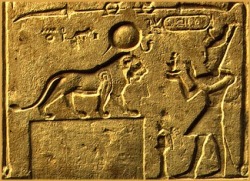
Miysis ist das griechische Wort für das ägyptische Mahes. Bereits in den Pyramidentexten wird Mahes mit der Bedeutung 'Löwe' benutzt, aber erst vom Mittleren Reich an bezieht sich das Wort in theophoren Namen auf eine Gottheit. Nach dieser Epoche wird der Begriff Mahes in dieser Doppelbedeutung von Löwe und Löwengott verwendet.
Der Kult des Löwengottes Mahes, dem Sohn von sowohl Bastet und Sachmet, konzentrierte sich auf Bubastis und Leontopolis. Im zuletzt genannten Ort wurde er als 'lebender Löwe' verehrt. Als Sohn der Bastet wurde er auch in Wadjet in Oberägypten verehrt. Die Epitheta des Mahes unterscheiden sich nicht von denen anderer Löwengottheiten. Er wird gewöhnlich in zwei Formen dargestellt - einer tiergestaltigen und einer teilweise menschengestaltigen.
Die Funktion des Mahes war die eines Kriegsgottes, eines Wächters heiliger Stätten und eines Feindvernichters. Mit Sonnenscheibe und Uräus versehen, scheint er mit dem Sonnengott verbunden und sogar mit ihm identifiziert worden zu sein.
Sein Kult verbreitete sich von den älteren, im Norden gelegenen Zentren nach Süden hin. Obwohl er wahrscheinlich vor der 22. - 26. Dynastie nicht weit verbreitet war, steigerte sich die Verehrung des Mahes ständig und war während der 30. Dynastie von besonderer Bedeutung. Während der Griechisch-Römischen Zeit wurde Mahes auch in Nubien verehrt. Man nimmt an, daß die Kuschiten in der Folge ihrer Kontakte mit Ägypten von den vielen Darstellungen des Mahes insbesondere auf Philae angeregt wurden und ihn mit einer der wichtigsten Gestalten ihres eigenen Pantheons, dem Löwengott Apedemak, identifizierten.